I'd be happy to try, Louis. I would love to see all those aircraft together. When does the new Heco wing at Museum Badolato open up?:wink2: -- AlI now have 5 different Heco pusher planes. Maybe I should photograph all of them together, and you can identify them for me.:smile2:
You are using an out of date browser. It may not display this or other websites correctly.
You should upgrade or use an alternative browser.
You should upgrade or use an alternative browser.
Heco Tinplate Models (2 Viewers)
- Thread starter maddadicus
- Start date
Louis Badolato
Lieutenant General
- Joined
- Apr 25, 2005
- Messages
- 18,442
I just sent Brad 4 photos of the 5 pusher planes together on an airfield diorama, so you aircraft experts can figure out which plane is which. All but one of the planes have one skid, the most recent plane has two skids. Note differences in the tails, and in the braces and rigging.
Michael,
Your Armored Car will go out Wednesday.:smile2:
Michael,
Your Armored Car will go out Wednesday.:smile2:
Louis Badolato
Lieutenant General
- Joined
- Apr 25, 2005
- Messages
- 18,442
My third Heco WWI British Mark IV tank arrived today. I will take some photos of the three Mark IV's and the Whippet together and ask Brad to post them for me when he gets a chance.:wink2:
Louis Badolato
Lieutenant General
- Joined
- Apr 25, 2005
- Messages
- 18,442
The officers and men of the Royal Tank Regiment load and maintain three Mark IV Tanks, named "Apollo", 'Erebus" and "Theseus", as the commanders receive intell from the commander of a Whippet Tank, all in preparation for an offensive at a little known French village called Cambrai.
I sent Brad 3 photos of the above described vignette with a polite request that he post them on this thread. I can only imagine he is busy with the upcoming holidays, so be patient gentlemen.:wink2:
I sent Brad 3 photos of the above described vignette with a polite request that he post them on this thread. I can only imagine he is busy with the upcoming holidays, so be patient gentlemen.:wink2:
jazzeum
Four Star General
- Joined
- Apr 23, 2005
- Messages
- 38,891
The officers and men of the Royal Tank Regiment load and maintain three Mark IV Tanks, named "Apollo", 'Erebus" and "Theseus", as the commanders receive intell from the commander of a Whippet Tank, all in preparation for an offensive at a little known French village called Cambrai.
I sent Brad 3 photos of the above described vignette with a polite request that he post them on this thread. I can only imagine he is busy with the upcoming holidays, so be patient gentlemen.:wink2:
Here are the photos. Very nice tanks.
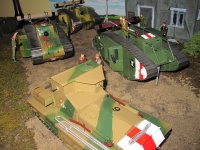
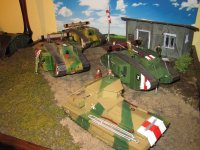
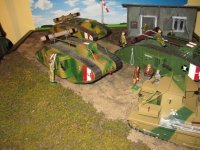
jazzeum
Four Star General
- Joined
- Apr 23, 2005
- Messages
- 38,891
I just sent Brad 4 photos of the 5 pusher planes together on an airfield diorama, so you aircraft experts can figure out which plane is which. All but one of the planes have one skid, the most recent plane has two skids. Note differences in the tails, and in the braces and rigging.
Michael,
Your Armored Car will go out Wednesday.:smile2:
Oops {eek3}, forgot to post these. Apologies to those who might have been waiting to see them.
Brad
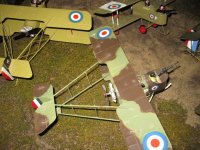
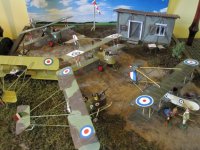
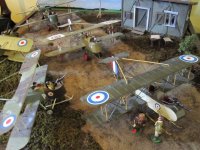
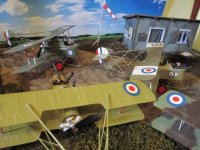
Spectacular tanks and planes, Louis. The tanks look especially nice. They just look like they should, with the boiler plate type construction. Real World War Oney. Very nicely colored and detailed. I will take a close look at the aircraft after turkey day, but they look like 4 of them are similar. The pushers are really nice models. -- Al
Louis Badolato
Lieutenant General
- Joined
- Apr 25, 2005
- Messages
- 18,442
Thanks again for posting these Brad, and Happy Thanksgiving!:smile2:
Last edited by a moderator:
Louis Badolato
Lieutenant General
- Joined
- Apr 25, 2005
- Messages
- 18,442
Spectacular tanks and planes, Louis. The tanks look especially nice. They just look like they should, with the boiler plate type construction. Real World War Oney. Very nicely colored and detailed. I will take a close look at the aircraft after turkey day, but they look like 4 of them are similar. The pushers are really nice models. -- Al
Thanks Jeff, Martyn and Al for the kind comments. It is my goal to have my collection become for Heco Tinplate Models what Martyn's collection has become for Trophy of Wales. If I can get Kevin on board, I would love to do a book on Heco like the 5 volumes so far on King & Country's early production.
Al, the darker green plane at the rear of the runway is a single seat pusher plane, the rest are two seaters. The newest two seater (in the front of the runway) has two skids (the rest have one) a different shaped fuselage and a different shaped tail with a triangular piece sticking up at the top which does not move like the rudder. Two of the remaining three (both solid light green) are identical, and have diagonal "X" shaped cross braces on the rear assembly. The last plane (green and brown camouflage) has a different rear assembly with perpendicular cross braces. I am pretty sure that there are two Vickers Gunbuses, one DeHaviland DH2 (or other) single seater, and 2 other different 2 seater pusher planes, one of which has two skids and a different fuselage, and the other of which has one skid an a different rear assembly.
Hi Louis. Not having much luck with definite ID's on the planes. Believe you are correct about the Gunbus'. The new 2-seater that you reference might be a FE2b. I say that because of the triangular piece which is characteristic of the FE2b, but the FE2b is a 3-bay aircraft and yours is 2-bay. I think this may be artistic license as a 3-bay FE2b would be very large. I think artistic license may be the answer to the single seat DH-2, also. The DH-2 was a 2-bay fighter and from the picture it appears the one you have is single bay but it looks like a DH-2. My sources are rather limited so it is quite possible that I am quite wrong about these but this is what I think. At any rate, they are quite an impressive example of British aviation in 1915-16. -- AlThanks Jeff, Martyn and Al for the kind comments. It is my goal to have my collection become for Heco Tinplate Models what Martyn's collection has become for Trophy of Wales. If I can get Kevin on board, I would love to do a book on Heco like the 5 volumes so far on King & Country's early production.
Al, the darker green plane at the rear of the runway is a single seat pusher plane, the rest are two seaters. The newest two seater (in the front of the runway) has two skids (the rest have one) a different shaped fuselage and a different shaped tail with a triangular piece sticking up at the top which does not move like the rudder. Two of the remaining three (both solid light green) are identical, and have diagonal "X" shaped cross braces on the rear assembly. The last plane (green and brown camouflage) has a different rear assembly with perpendicular cross braces. I am pretty sure that there are two Vickers Gunbuses, one DeHaviland DH2 (or other) single seater, and 2 other different 2 seater pusher planes, one of which has two skids and a different fuselage, and the other of which has one skid an a different rear assembly.
Louis Badolato
Lieutenant General
- Joined
- Apr 25, 2005
- Messages
- 18,442
Martyn,
I know you did (you sent me a PM or an e-mail), and I posted a thank you for your efforts on this thread a while back. There are a lot of great guys on this forum who have helped out other forum members over the years, and you are one of the best of them!:smile2:
Thanks again for taking the time to ask.
Louis
Martyn,
This is what I had previously posted about you on post #322, page 33 of this thread:
I just wanted to say a big thank you to Martyn (GICOP), who was kind enough to make the effort to enquire with the owners of MKL Models, one of the "big three" Heco Tinplate dealers beforeTony and Adele retired, about any left over Heco items that might be willing to part with.
Martyn's efforts on my behalf exemplify the kind of good fellowship that I have repeatedly experienced from the members of this forum.
Sadly, MKL had long since sold off its Heco stock, but the fact that Martyn went out of his way for me still made my day. Thanks, Martyn!
Louis Badolato
Lieutenant General
- Joined
- Apr 25, 2005
- Messages
- 18,442
Hi Louis. Not having much luck with definite ID's on the planes. Believe you are correct about the Gunbus'. The new 2-seater that you reference might be a FE2b. I say that because of the triangular piece which is characteristic of the FE2b, but the FE2b is a 3-bay aircraft and yours is 2-bay. I think this may be artistic license as a 3-bay FE2b would be very large. I think artistic license may be the answer to the single seat DH-2, also. The DH-2 was a 2-bay fighter and from the picture it appears the one you have is single bay but it looks like a DH-2. My sources are rather limited so it is quite possible that I am quite wrong about these but this is what I think. At any rate, they are quite an impressive example of British aviation in 1915-16. -- Al
Al,
In the Heco Catalogue there are both an F2b and an FE2b listed. It sounds very possible that you may be correct. Thanks for the efforts at identification.:smile2:
Good show. The F2b is an entirely different aircraft than the FE2b. The F2b, the Bristol, was a tractor 2-seater that was widely considered the best British 2-seater (and some say the best plane, period) of WW1. It was such a good design that it was still in use a decade after the war. -- AlAl,
In the Heco Catalogue there are both an F2b and an FE2b listed. It sounds very possible that you may be correct. Thanks for the efforts at identification.:smile2:
Louis Badolato
Lieutenant General
- Joined
- Apr 25, 2005
- Messages
- 18,442
Good show. The F2b is an entirely different aircraft than the FE2b. The F2b, the Bristol, was a tractor 2-seater that was widely considered the best British 2-seater (and some say the best plane, period) of WW1. It was such a good design that it was still in use a decade after the war. -- Al
Al,
In addition to the DH2 Single Seater, I also found reference to a Royal Aircraft Factory F.E.8 single seater pusher plane, and a Vickers F.B.12 single seater pusher plane. Which of these do you think my single seater pusher plane might be?
Hi Louis. I believe that your aircraft is probably the DH-2, not the FE8 or the FB12. The FE-8 has a 2-bay strut arrangment, as does the DH-2, but has an even bigger wingspan. The key is the boom/tail structure. The DH-2 booms meet at the tail with the tailplane mounted on top of the boom, as in your model. The FE8 tail structure is quite different, with the two booms tapering to seperate points with the tailplane mounted where the points meet on either side. The Vickers FB12 has far too many stuctural differences to be your model. It has rounded wingtips, a tail structure similar to the FE8, and a fuselage mounted between, but never touching, the wings, like the F2b Bristol. Hope this helps. -- AlAl,
In addition to the DH2 Single Seater, I also found reference to a Royal Aircraft Factory F.E.8 single seater pusher plane, and a Vickers F.B.12 single seater pusher plane. Which of these do you think my single seater pusher plane might be?
Louis Badolato
Lieutenant General
- Joined
- Apr 25, 2005
- Messages
- 18,442
Kevin Elliott e-mailed me yesterday and suggested coming to New York next summer to shoot the photos for a book on Heco Tinplate Models. I am going to contact my buddy Clive (who is friends with Tony Williams) to see if we can get Tony and Adele's permission to use his photos and old catalogues in the book for the items we do not have access to, and perhaps to get a complete list of Heco production.:smile2:
Louis Badolato
Lieutenant General
- Joined
- Apr 25, 2005
- Messages
- 18,442
As John Jenkins and Brad Lewin can attest, my airfield diorama had become ridiculously overcrowded, so, as a solution, I decided to move some of my lighter, sturdier Heco Tinplate aircraft into the "sky" above the airfield. I decided to divide it up with WWI aircraft flying to the left of the airfield, interwar era planes flying over the middle, and WWII airfcraft flying over the right side of the airfield. I mounted the same sturdy hooks in the ceiling I had previously used to suspend K&C paratroopers over the airfield, and suspended the planes (none of which weighs more than 1/2 a pound) using 12 lb. test fishing line.
I sent Brad 5 photos of the airspace above my aerodrome, with a polite request that he post them on this thread. Starting in 1918, the first photo is of a Spad of the American Expeditionary Force's 91st "Hat in the Ring" Squadron diving on and preparing to shoot down an Albatros DV, the second is a Sopwith Camel on the tail of a Pfalz DIIIa.
For the third photo, we fast forward from 1918 to 1939, the airfield in Devon, Roxsborough. The only squadron that would fly Gloster Gladiators in the Battle of Britain sends up a patrol of the gleaming silver aircraft.
For the fourth and fifth photos, we move foward to July and August, 1940, in the heart of the Battle of Britain. 601 Squadron, stationed in Tangmere, Sussex sends up a patrol of Hawker Hurricanes in response to a report of Dorniers and Heinkells crossing the Channel at Angels 12.
I sent Brad 5 photos of the airspace above my aerodrome, with a polite request that he post them on this thread. Starting in 1918, the first photo is of a Spad of the American Expeditionary Force's 91st "Hat in the Ring" Squadron diving on and preparing to shoot down an Albatros DV, the second is a Sopwith Camel on the tail of a Pfalz DIIIa.
For the third photo, we fast forward from 1918 to 1939, the airfield in Devon, Roxsborough. The only squadron that would fly Gloster Gladiators in the Battle of Britain sends up a patrol of the gleaming silver aircraft.
For the fourth and fifth photos, we move foward to July and August, 1940, in the heart of the Battle of Britain. 601 Squadron, stationed in Tangmere, Sussex sends up a patrol of Hawker Hurricanes in response to a report of Dorniers and Heinkells crossing the Channel at Angels 12.
jazzeum
Four Star General
- Joined
- Apr 23, 2005
- Messages
- 38,891
As John Jenkins and Brad Lewin can attest, my airfield diorama had become ridiculously overcrowded, so, as a solution, I decided to move some of my lighter, sturdier Heco Tinplate aircraft into the "sky" above the airfield. I decided to divide it up with WWI aircraft flying to the left of the airfield, interwar era planes flying over the middle, and WWII airfcraft flying over the right side of the airfield. I mounted the same sturdy hooks in the ceiling I had previously used to suspend K&C paratroopers over the airfield, and suspended the planes (none of which weighs more than 1/2 a pound) using 12 lb. test fishing line.
I sent Brad 5 photos of the airspace above my aerodrome, with a polite request that he post them on this thread. Starting in 1918, the first photo is of a Spad of the American Expeditionary Force's 91st "Hat in the Ring" Squadron diving on and preparing to shoot down an Albatros DV, the second is a Sopwith Camel on the tail of a Pfalz DIIIa.
For the third photo, we fast forward from 1918 to 1939, the airfield in Devon, Roxsborough. The only squadron that would fly Gloster Gladiators in the Battle of Britain sends up a patrol of the gleaming silver aircraft.
For the fourth and fifth photos, we move foward to July and August, 1940, in the heart of the Battle of Britain. 601 Squadron, stationed in Tangmere, Sussex sends up a patrol of Hawker Hurricanes in response to a report of Dorniers and Heinkells crossing the Channel at Angels 12.
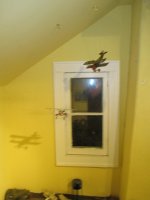
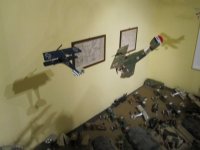
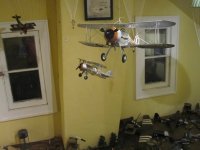
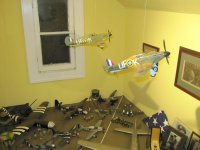

Users who are viewing this thread
Total: 3 (members: 0, guests: 3)

